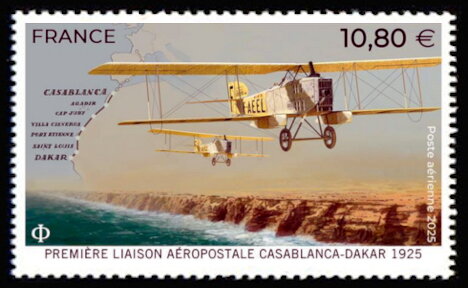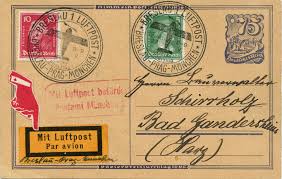Stamp: First Casablanca-Dakar Airmail Flight, Centenary (France 2025)
First Casablanca-Dakar Airmail Flight, Centenary (France 2025)
02 June (France ) within release First Casablanca-Dakar Airmail Flight, Centenary goes into circulation Stamp First Casablanca-Dakar Airmail Flight, Centenary face value 10.80 Euro
| Stamp First Casablanca-Dakar Airmail Flight, Centenary in catalogues | |
|---|---|
| Colnect codes: | Col: FR 2025.06.02-01 |
Stamp is horizontal format.
Issued in both full panes of 12 and mini-sheets of 10Also in the issue First Casablanca-Dakar Airmail Flight, Centenary:
- Stamp - First Casablanca-Dakar Airmail Flight, Centenary face value 10.80;
- Full Pane - First Casablanca-Dakar Airmail Flight, Centenary face value 12*10.80;
- Mini Sheet - First Casablanca-Dakar Airmail Flight, Centenary face value 10*10.80;
Stamp First Casablanca-Dakar Airmail Flight, Centenary it reflects the thematic directions:
An aircraft (pl. aircraft) is a vehicle that is able to fly by gaining support from the air. It counters the force of gravity by using either static lift or the dynamic lift of an airfoil, or, in a few cases, direct downward thrust from its engines. Common examples of aircraft include airplanes, rotorcraft (including helicopters), airships (including blimps), gliders, paramotors, and hot air balloons.Part 1 (Definitions and Abbreviations) of Subchapter A of Chapter I of Title 14 of the U. S. Code of Federal Regulations states that aircraft "means a device that is used or intended to be used for flight in the air."
Aviation is the practical aspect or art of aeronautics, being the design, development, production, operation and use of aircraft, especially heavier than air aircraft. The word aviation was coined by French writer and former naval officer Gabriel La Landelle in 1863, from the verb avier (synonymous flying), itself derived from the Latin word avis ("bird") and the suffix -ation.
Postal history is the study of postal systems and how they operate and, or, the study of the use of postage stamps and covers and associated postal artifacts illustrating historical episodes in the development of postal systems. The term is attributed to Robson Lowe, a professional philatelist, stamp dealer and stamp auctioneer, who made the first organised study of the subject in the 1930s and described philatelists as "students of science", but postal historians as "students of humanity". More precisely, philatelists describe postal history as the study of rates, routes, markings, and means (of transport).



